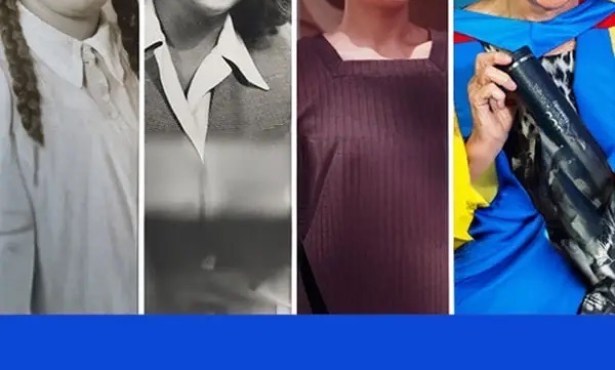National Poetry Month Book Reviews
David Starkey Reviews 30 Works of Poetry
April is National Poetry Month, so David Starkey, former Santa Barbara Poet Laureate and current Indy book reviewer, has for the third year in a row undertaken the daunting task of reading and summarizing 30 books of poetry — one for each day of the month. Below are the results of his endeavor.
Adrienne Rich, Collected Poems, 1950-2012: The poetic antidote to Trumpism was written long before the current president took office. Rich’s work is complex and driven and couldn’t be more relevant, as in this passage from “Trying to Talk with a Man,” where she confronts a scientist at a bomb testing site and realizes he is “talking of the danger / as if it were not ourselves / as if we were testing anything else.”
Rita Dove, Collected Poems, 1974-2004: Dove may be best known for writing about the struggles faced by African Americans, but this comprehensive gathering of mostly short poems from the first 30 years of her career shows her to be interested in everything from Frida Kahlo to grape sherbet to math flash cards. “If you feel strange,” she writes, “strange things will happen to you.”
Monty Reid, Meditatio Placentae: Reid’s book consists of strange and wonderful sequences that reimagine the world from unlikely perspectives. “Household Gods,” for instance, features poems about socks, lint, keys, and tweezers. The title poem is a surprisingly touching dramatic monologue spoken by a mother’s afterbirth: “unembraceable / and always between this place and another.”
Alan Gillis, Scapegoat and Other Poems: Initially, a reader may be carried away by the music of Gillis’s verse, the lush assonance and alliteration, the clever rhymes (“kite”/“gobshite”) and half-rhymes (“frog” / “brogue”). Yet the most powerful aspect of this volume of selected poems may be its careful examination of working-class life in Ireland and Scotland.
Emily Dickinson, Envelope Poems: Featuring both front- and back-color reproductions of the recycled envelopes on which Dickinson wrote — mostly in pencil — “scraps” of poetry and poetic messages, Envelope Poems also includes text transcriptions of her sometimes impenetrable handwriting. Not exactly a collection of Dickinson’s poetry, the book is nevertheless a work of art in its own right.
Joshua Bennett, The Sobbing School: If there were any doubt that the music and rhythm of poetry can energize and amplify its message, Bennett’s smart, focused first collection offers indisputable evidence. “Not the body / but its bad / alibi. Its black / & blueprint,” he writes in “On Flesh,” one of many poems melding pain and song.
Rajiv Mohabir, The Taxidermist’s Cut: The sometimes grisly art of taxidermy, in which death is cleverly disguised as life, serves as a dominant metaphor for poems that explore everything from “Homosexual Interracial Dating in the South” to the poet’s “chutney / of Creole and Hindi” to creatures as disparate as the whale shark and the cicada.
Stevie Smith, All the Poems: Smith is known primarily in America for one poem, “Not Waving but Drowning,” so this compendium can’t help but present a broader picture of her achievement. Often decorated with her weird and whimsical pen-and-ink drawings, the hundreds of poems in this collection exhibit a dark, desperate humor. “Serious people, serious people,” she writes, “I should think it was serious to be such people.”
Bill Knott, I Am Flying into Myself: Selected Poems, 1960-2014: Knott’s work is deceptively simple. “Poem,” for example, reads, in its entirety: “Even when the streets are empty, / even at night, the stopsign / tells the truth.” Yet the work is never as straightforward as it initially appears, and the real pleasure of Knott’s poetry lies in its rereading.
Dean Rader, Self-Portrait as Wikipedia Entry: The titles of Rader’s poems are so clever that the poems practically write themselves. Among them: “The Poem Chooses Its Own Adventure.” Also: “Unable to Look Away from the Portrait of My Grandfather atop His Casket, I Write a Poem about My Newborn Son on the Back of the Funeral Program.”
Sylvia Legris, The Hideous Hidden: Autopsy is the theme of Legris’s often gruesome book. “[G]ut-ribboning / guttata,” she calls it in one poem, dissecting — in other poems — “the bulbous presciently baroque liver,” “the long-exhausted lungs,” “the meat-muscular dumbstruck tongue,” “the city of organs.” Not for the squeamish.
Grace Bonner, Round Lake: The suicide of the poet’s sister, evoked in the book’s opening “Incantation,” hovers ghost-like over many of these poems. Yet despite its sadness, Bonner’s poetry can’t help but embrace the small joys of memory and careful observation: “What’s left of you / arrives in morning / sun streaming.”
William Trowbridge, Vanishing Point: The highlight of Trowbridge’s funny and nostalgic book is the sequence “Oldguy: Superhero,” about an elderly and perpetually affronted defender of freedom and justice, whom even Superman, after scribbling “an autograph on Oldguy’s utility belt,” disrespects with a “‘Move it along, Gramps.’”
Donika Kelly, Bestiary: In this wildly inventive collection, Kelly writes love poems for mermaids and werewolves and centaurs, minotaurs and griffons and chimeras, but perhaps the most telling of these love poems is the one addressed to herself. “I am lonely as a bear,” she writes, and then, in the next line, “I am no good at bearish things.”
Solmaz Sharif, Look: Collage and erasure are poetic techniques well suited to describing the United States’ military intervention in the Middle East, and Sharif uses them to stunning effect in her first book. If the long sequence “Personal Effects” is the collection’s most ambitious poem, perhaps its most moving is “Reaching Guantánamo,” a series of redacted letters from a wife to her imprisoned husband.
Ishion Hutchinson, House of Lords and Commons: Attentive readers will hear in this year’s National Book Critics Circle Award winner not just echoes of Derek Walcott and Geoffrey Hill, but also, more distantly, Gerard Manley Hopkins: “When my boy-self played séance in the Spanish / needles, havocking the bees, their bronze staining // my shanks, rain pistils sprung out of the earth and buried / glass splinters under my clothesline.”
Paisley Rekdal, Imaginary Vessels: The centerpiece of Rekdal’s long, ambitious, multifaceted book is a series of poems, accompanied by photographs, examining skulls unearthed from the Colorado Mental Health Institute, about which she writes with distinct tenderness: “I’d cradle this if I could, a lover’s head laid / to my breast: the ossicles’ seismic curves a map / of madness — heritable grief.”
Robert Wrigley, Box: Ravens and mountains, pine forests and stars are scattered throughout Wrigley’s 10th collection. These are poems to be read by firelight, alone, while autumn rain plays against the roof and memories of people, places, and things long lost, “acknowledged / in bewilderment or amazement” pass by in “a rush of recall.”
David Hernandez, Dear, Sincerely: “By dusk, / while the sky’s / lush blue // drained out / quicker, / I felt my life // ending. It could / not have been / any fuller,” Hernandez writes in the voice of a mayfly at the end of his 24 hours on Earth. Doorknobs, mylar balloons, and team mascots get similarly imaginative attention in this spectacular collection.
Aaron Smith, Primer: “[Y]ou don’t want / your stupid, tiny life to end,” Smith acknowledges in “This Exact Sky,” and his collection skillfully captures that imperfect balance we all feel between annoyance and satisfaction, unfounded fear and unexpected courage, despair and pure joy.
Mary Stewart Hammond, Entering History: In our politically polarized times, it’s daring for an affluent woman to try and write a sympathetic poem about her husband reading Henry James as he listens to Gershwin and reminisces about Rome, while sitting comfortably in their summer cottage by the shore, yet somehow Hammond manages the feat — and others of similar unlikelihood.
Monica Youn, Blackacre: The fact that Monica Youn is a former attorney accounts for her use of the legal term “blackacre” (a placeholder name for a fictitious piece of land), but her transmutations of the concept into goldacre, blueacre, brownacre, etc., are reminiscent of the restless experimentation of Jorie Graham, and Youn’s verse is anything but lawyerly.
Alison Pelegrin, Waterlines: In poems like “Communion with the Rebel Flag,” “Red State Epistle,” and “Dirty South,” Pelegrin wrestles with her vexatious identity as a white Southerner, weighing her envy for “more civilized places” against pride in her “treasured drawl,” ultimately deciding that while hating her redneck neighbors and kin “would be easiest … after all this time / I find my eyes adjusting to the light.”
Genevieve Lehr, Stomata: “Myth is a way to frame grief,” Lehr writes in one poem; “Metamorphosis is everywhere,” she states in another; and “metaphor / is achingly at home / among birds” she claims in still another. The lines that follow enrich and complicate these nuggets of wisdom in poems that often range across many pages.
Robert Pinsky, At the Foundling Hospital: Pinsky’s subject matter is varied — names, clichés, the origin of foods, fungicides, war veterans — but his focus is always on locating the permanent in the transient and investigating how we make meaning of our confounding world: “Mind, mind, mind pulled / Taut in its bony shell, / Dreaming up Heaven and Hell.”
Adrian Matejka, Map to the Stars: Hip-hop, jazz, and funk guide Matejka’s sly and successful aesthetic choices. You can hear his sense of rhythm and play in many of the poem’s titles: “Trumpets Up in Here,” “Code-Switching Blacks,” “Sounds in Sequential Order (Edit),” “Emily Dickinson feat. Basketball & EPMD.”
Harry Clifton, Portobello Sonnets: Thirty-five sonnets celebrate Clifton’s Dublin neighborhood, a place of “redbrick terraces” and night bakeries, of rooms shared by lovers above the “wholesale butcher,” and garages catering to “the blackened, burnt-out wrecks / Of overnight derangements,” where “Even Christ, in his unrecorded years, / Might have lingered.”
Marci Calabretta Cancio-Bello, Hour of the Ox: Calabretta Cancio-Bello weaves Korean folktales, myths, and family reminiscences into a series of poems punctuated by the reincarnation of a dead brother as an octopus, a sunflower, a penumbra, a chrysanthemum. Throughout the book, she accentuates our varied thirsts and hungers and “the silences tucked / … beneath your tongue.”
Eamon Grennan, There Now: The landscapes of upstate New York and the west of Ireland appear in almost every poem in a book that revels in close observation of the natural world, especially birds: “gunmetal grackles,” plovers that “bescreech the rainswept tide,” “bluejays / finches cardinals chickadees and white- / throated sparrows … all making their / spring-loaded hunger-honed presence / clearly known.”
Rosmarie Waldrop, Gap Gardening: Selected Poems: “Even the straightest road conceals detours and forks,” Waldrop writes in “Splitting Image,” though no one could accuse her poetry of resembling a straight road. Instead, her poems fragment, rejoin, dissolve, and reassemble again. Although it’s not always possible to follow the thread of Waldrop’s sentences, there’s no doubt that the mind mapping her mazes is a brilliant one.



